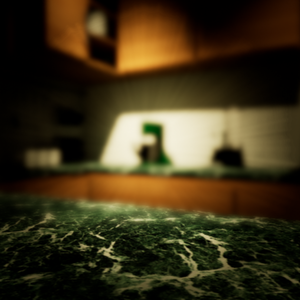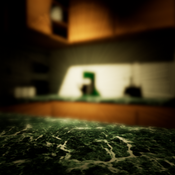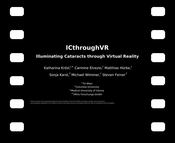Information
- Publication Type: Conference Paper
- Workgroup(s)/Project(s):
- Date: March 2019
- Publisher: IEEE
- Location: Osaka, Japan
- Lecturer: Katharina Krösl
- Event: IEEE VR 2019, the 26th IEEE Conference on Virtual Reality and 3D User Interfaces
- DOI: 10.1109/VR.2019.8798239
- Call for Papers: Call for Paper
- Booktitle: 2019 IEEE Conference on Virtual Reality and 3D User Interfaces
- Conference date: 23. March 2019 – 27. March 2019
- Pages: 655 – 663
- Keywords: vision impairments, cataracts, virtual reality, user study
Abstract
Vision impairments, such as cataracts, affect how many people interact with their environment, yet are rarely considered by architects and lighting designers because of a lack of design tools. To address this, we present a method to simulate vision impairments caused by cataracts in virtual reality (VR), using eye tracking for gaze-dependent effects. We conducted a user study to investigate how lighting affects visual perception for users with cataracts. Unlike past approaches, we account for the user's vision and some constraints of VR headsets, allowing for calibration of our simulation to the same level of degraded vision for all participants.Additional Files and Images
Weblinks
BibTeX
@inproceedings{kroesl-2019-ICthroughVR,
title = "ICthroughVR: Illuminating Cataracts through Virtual Reality",
author = "Katharina Kr\"{o}sl and Carmine Elvezio and Matthias
H\"{u}rbe and Sonja Karst and Michael Wimmer and Steven
Feiner",
year = "2019",
abstract = "Vision impairments, such as cataracts, affect how many
people interact with their environment, yet are rarely
considered by architects and lighting designers because of a
lack of design tools. To address this, we present a method
to simulate vision impairments caused by cataracts in
virtual reality (VR), using eye tracking for gaze-dependent
effects. We conducted a user study to investigate how
lighting affects visual perception for users with cataracts.
Unlike past approaches, we account for the user's vision and
some constraints of VR headsets, allowing for calibration of
our simulation to the same level of degraded vision for all
participants.",
month = mar,
publisher = "IEEE",
location = "Osaka, Japan",
event = "IEEE VR 2019, the 26th IEEE Conference on Virtual Reality
and 3D User Interfaces",
doi = "10.1109/VR.2019.8798239",
booktitle = "2019 IEEE Conference on Virtual Reality and 3D User
Interfaces",
pages = "655--663",
keywords = "vision impairments, cataracts, virtual reality, user study",
URL = "https://www.cg.tuwien.ac.at/research/publications/2019/kroesl-2019-ICthroughVR/",
}


 image
image paper_preprint
paper_preprint video
video

